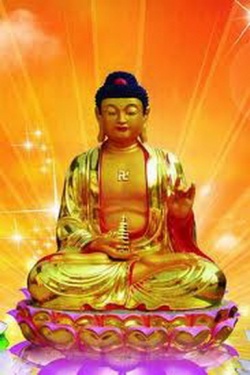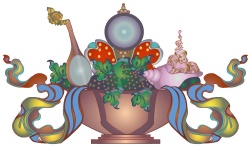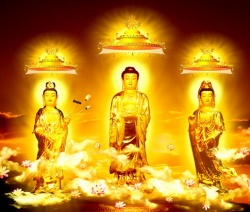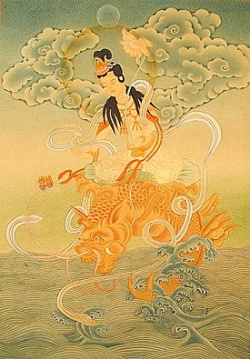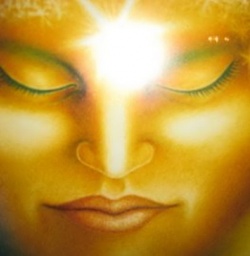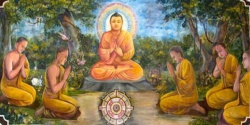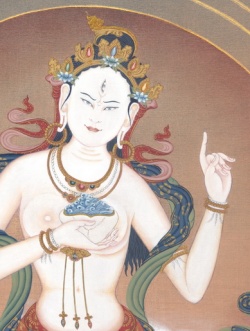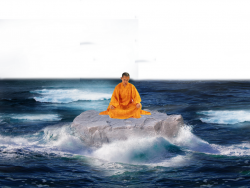Meditation (Japan)
Historically, meditation has played an important role in Buddhist thought and practice. The centrality of meditation to Buddhist understandings of spiritual attainment derives from the paradigmatic actions of the Buddha himself. Indeed, the Buddhafs perfection through meditational practice made possible his supreme enlightenment.
Over the years Buddhists have developed a large number of meditational disciplines and practices. These include techniques.employed by monks and laypeople alike.to calm the mind to better deal with the exigencies and problems of everyday life. They also include more advanced techniques that are used primarily though not exclusively by monks.1
Many of the more advanced meditational techniques are, in their general features, shared by many Buddhist traditions, including Hinayana/ Theravada,Mahayana, and Esoteric.
Such techniques include various degrees of asceticism; accepting the guidance of an already accomplished master; the use of various objects, including the physical functions of the body, for contemplation and concentration; the concentrated, often rhythmatic recitation and/or repetition of sacred words, formulaic phrases, or texts; and the use of specific bodily postures and activities. To these techniques may be added others that are also very common, but limited more to Mahayana and especially Esoteric traditions:
the sustained use of bells, chimes, and other musical devices; the visualization of cosmic Buddhas, bodhisattvas, and other deities; and the manipulation of mental and material symbols representing cosmic totalities. To these we can add a meditational technique found expressly in certain Esoteric traditions: sexual activity.
The advanced meditational techniques typically have three primary purposes. They are aimed at the acquisition of supranormal states of consciousness. They are also aimed at the attainment of various powers.for example, the ability to remember onefs past lives.accessible through, during, and from those states of consciousness.
Last, these advanced meditational techniques are ultimately aimed at the attainment of the highest religious goal, which is, in all Buddhist traditions, a product of the highest form of mental and bodily cultivation. Generally speaking, the highest religious goal for the advanced meditational practitioners of the Hinayana/Theravada traditions is the attainment of nirvana.
Nirvana is a goal that breaks the practitioner free from phenomenal becoming.a becoming that is especially produced by desire and a steadfast attachment to a permanent self h and is ultimately characterized by the absence of self, by impermanence, and by suffering. Ideally, the advanced Hinayana/Theravada meditational techniques allow one to purify the mind and body of all desire and the attachment to self.
These techniques are designed to facilitate and produce the complete mental and bodily calm that puts an end to the burning psychosomatic forces that produce phenomenal reality. It is therefore not surprising that a common Theravada image of complete attainment to nirvana is that of a flame being extinguished.
Like their Hinayana/Theravada counterparts, the more advanced meditational practitioners in most if not all Mahayana and Esoteric traditions view the production of the phenomenal world in light of the volitional forces of desire and attachment to self. However, there are significant doctrinal differences between the two types of meditational practitioners and thus differences in their perceptions of the highest religious goal.
Doctrinally, for instance, although many Mahayana and Esoteric practitioners also believe that suffering and impermanence warrant serious religious concern and attention, these practitioners also view existential suffering and impermanence to be the product of a deluded mind that ultimately inhibits onefs ability to act in the world for the sake of all.h
In this religious view, various types of meditation can function as significant methods for increasing onefs capacity to engage.in an extremely proactive manner.in the phenomenal world out of existential concern for the gsufferingh of others.
Many Mahayana and Esoteric practitioners have used very diversified, complex, and multisensory meditational techniques focusing on the attainment of a Buddhist goal that is rather different from the Hinayana/ Theravada one. These modes of practice aim to achieve a kind of enlightenment through which the practitioner attains the unifying and liberating recognition that all reality,
including all cosmic reality and all individual reality, is constituted by an emptiness or voidness that simultaneously pervades every time and place. Mahayana and Esoteric practitioners often specifically identify this emptiness or voidness with the Buddha and Buddhahood itself.
The excerpt that follows describes an advanced formof Esoteric practice that has been developed in Japan by adherents of the Shingon sect.
Taiko Yamasaki
The Morning Star meditation (gumonji-ho) is a practice in which the mantra (a sacred word, sound, or phrase) of the bodhisattva Kokuzo is recited one million eighty thousand times (gone millionh in Shingon terms) over a set period of time. The Morning Star ritual manual instructs the practitioner to become one body with the universal Dharma Realm. (The Dharma Realm is the realm of Truth as understood within the Shingon tradition.)
Following the Morning Star ritual instructions, the practitioner uses one mudra (a symbolically significant positioning of the hands) and one mantra in a concentrated meditation focused on direct experience of the universe through union with the deity of the morning star.
The name gumonji-ho means literally technique for seeking hearing retaining,h meaning that this practice is supposed to result in the ability to remember everything seen and heard. The Morning Star meditation was, in fact, practiced in Japan as early as the Nara period (710 .784 c.e.) to develop the memory and aid in memorizing sutras.
Its esoteric purpose, however, is to deepen the samadhi (meditative concentration) state in order to experience the self as universal void of potentiality. It is here called the Morning Star meditation because it involves visualization of the deity Kokuzo in the form of Venus, the morning star.
A central Mikkyo meditation both in the past and today, it is one of the important esoteric practices of Shingon. (Mikkyo is a type of teaching and practice that is believed to culminate in the transforming activity and presence of Wisdom experienced in the complexity of day-to-day life.) The source text of this practice is the Kokuzo Bosatsu Noman Shogan Saisho-shin Darani Gumonji-ho (Kokuzo Bodhisattvas Power-Filled Wish-Fulfilling Supreme-Mind Dharani Technique for Seeking Hearing and Retaining).
This text was translated from the original Sanskrit by Shubhakarasimha in China in 717, and brought to Japan the following year. The Morning Star meditation was therefore known and practiced in Japan some time before Kukai (774 .835) brought the Shingon lineage from China. It is considered to be among the early elements of pure Mikkyo to arrive in Japan.
Various ritual manuals of the Morning Star meditation were written in Japan based on Shubhakarasimhas Chinese translation. Although the ritual was formalized in Japan, it clearly originated in India, where, for example, at the beginning of the ritual the practitioner would seal milk, symbolizing the nectar of enlightenment, into a container.
When opened at the end, the manner in which the contents had fermented was believed to indicate how successful the practice had been. In Japan, however, milk was uncommon, and during much of the year is as likely to freeze as to ferment, necessitating a change in this part of the ritual.
Shubhakarasimhas translation of the source text still exists, and its most important steps have been adhered to in the Japanese ritual manuals. Although the title of this text is long, the contents are brief, emphasizing recitation of the mantra gone millionh times. Kukai used this text to perform the Morning Star meditation, and Shingon considers this to be the practice by which he first experienced the nature of the esoteric teachings.
An important practice not only in Kukaifs own life but in the history of Shingon, the Morning Star meditation traditionally has had a strong appeal in Japan. Kakuban (a significant and controversial Shingon innovator and reformist who lived from 1095 to 1143), for example, performed it eight times.a prodigious feat.
The Morning Star meditation is not a required practice for Shingon priests, nor does it have any relationship to the system of seniority within the priesthood. Because of its rigors, however, there are relatively few priests today who have completed the Morning Star meditation. It seems to have been much more widely performed, though probably in less rigid forms, during the eighth century, when laymen were also initiated into its practice.
It is not known who transmitted the practice to Kukai. Legend has it that a priest named Gonzo, among the first masters of the Morning Star
2. Editorsf note: Taoism is a Chinese religion that influenced Buddhism in East Asia. meditation in Japan, was Kukaifs teacher. In any case, after encountering his nameless master, the young Kukai sought out isolated places on the Pacific coast and amid deep gorges on the mountainous island of Shikoku in which to practice the Morning Star meditation.
Kukai wrote in the Sango Shiiki (Indication of the Basis of the Three Teachings): Here a priest gave me the Morning Star meditation of Kokuzo. In the text was written, gIf one follows this technique and recites this mantra one million times, the ability to memorize the words of all the teachings will be gained.
Believing the words of the great master to be true, I hoped to kindle a blaze out of this flying spark. I climbed to the peaks of Tairyu Mountain in the country of Awa, and immersed myself in recitation at Cape Muroto in Tosa. In the echoing valleys the image of the Morning Star appeared. Celestial Bodies and Meditation on the Universe Mikkyo actively employs celestial bodies
for meditation on the Dharma Body (a name for the ultimate reality as understood within the Shingon tradition). In the Morning Star meditation the focus of ritual is the mantra, while the subject of esoteric union is the universe symbolized by Venus.
Shingon considers the Morning Star meditation to refer back to the historical Buddhafs experience of seeing the bright morning star at the moment of his enlightenment under the bodhi tree. Mikkyo also has a number of star rituals derived from Chinese Taoist astrology, performed to avert misfortune and to prolong life.2 Unlike the Morning Star meditation, these star rituals are for material benefit, but remain, nevertheless, representative esoteric practices.
Within the Morning Star meditation hall hangs a painting of the deity Kokuzo Bodhisattva, whose qualities are also symbolized by the morning star. The actual planet (Venus) is also used in the meditation, and is viewed through a special window.
Although Venus is not always visible, the subject of the practice is not simply the planetary body but the dynamic cosmos which, in the esoteric understanding, is embodied in the painting as well. The practitioner employs the planet, the painting of the deity, and the visualized image of the planet-deity as a means to experience suprapersonal truth.
In the painting used in the Morning Star meditation, Kokuzo is depicted in color on wood within a moon disk about one foot in diameter.
His body is gold, radiating beams of light. Seated on a lotus throne, he wears the crown of the five Buddhas. His left hand holds the stem of a pale red lotus on which rests a blue wish-fulfilling gem emanating yellow flames. His right hand is extended, palm up, fingers bent down, in the wish-bestowing (yogan) mudra.
Kokuzo is a deity of wisdom, virtue, and good fortune, whose activity is to fulfill all wishes. His direction is south. The esoteric tradition considers this the direction from which all treasures come, and south is also associated with the Buddha Hosho, whose name means giving birth to treasure.h Kokuzofs name literally means pository of the void, void here indicating not merely nothingness, but the mysterious potentiality that gives rise to all phenomena.
The samadhi (concentration) state of the Morning Star meditation focuses on the wish-fulfilling gem, a symbol of void-potentiality. The wish-fulfilling gem embodies Kokuzofs enlightenment energy, the universe itself which evolves eternally in perfect freedom, oblivious to humansf attempts to delimit it in their own understanding.
In the Morning Star meditation the practitioner concentrates exclusively on the single practice of union with the deity, the planet Venus. Focusing his being in this way on the distant morning star (symbolizing the universe), he seeks to unite with the source of the mind.
The Practice of the Morning Star
The Morning Star meditation hall traditionally is built in an isolated, natural setting where the sky and stars are visible. (In ancient times it was also performed in the open.) Only a few temples exist in Japan today where this meditation may be practiced: Tairyu-ji in the Awa region on Shikoku, Kongo-ji in Kochi, Mount Misen on the island of Miyajima in the Inland Sea,
and the Shinbessho on Mount Koya. The practice hall for the Morning Star meditation is built so that its east, west, and south sides are open and uncrowded, facing natural landscapes in the distance. The east side in particular must not be closed by trees or other buildings.
The hall is small, usually four and one-half tatami mats (about nine square feet) to six mats in area. High in the east wall is a small window through which the practitioner, who sits facing this wall, can see the stars. Hanging on this same east wall, the painting of Kokuzo is kept covered with a white cloth except during the time of meditation. The room is lit only by a small oil lamp which is kept burning throughout the ritual.
3. Editorsf note: Mandala, in this context, refers to a visual representation of the cosmos as understood within the Shingon tradition.
The source text for the Morning Star meditation contains a brief reference to a gwooden mandala,h a four-legged wooden platform about forty centimeters square, which is still used today. Like the larger platform altars, it functions as a place to summon the deity from its essential realm.
Symbolizing the deityfs enlightenment, the altar is immediately below the painting, and offerings are placed on a stand before it. To ensure its tranquility and ease of concentration, the altar is not touched during the practice; neither is the water in the flower vase changed, though fresh water is added.
The gflowersh are made from the leaves of the kaya tree (Torreya nucifera), and kaya oil is burned in the lamp. In fact, every ritual performed with the six offering implements employs some part of this tree.
In the past, the Morning Star meditation took one hundred days, but now ordinarily takes fifty days. The date for beginning the meditation is chosen by counting back from the day on which it ends, which must be marked by a solar or lunar eclipse. The closing ritual takes place at the exact time of the eclipse.
The number of recitations to be done each day is calculated precisely according to the length of the practice. If fifty days, for example, the practitioner must recite the mantra of the Kokuzo Bodhisattva gtwenty thousandh times (actually 21,600) daily. Each day has equal sittings of the same length and intensity, so that a continuous rhythm can be maintained throughout the practice. Special rituals mark the opening and closing days, but the ritual performed during all the intervening days remains exactly the same.
Since the mantra recitations must be counted, the practitioner uses a rosary and a device rather like a cribbage board with pegs, each of which stands for a certain number of recitations counted with the rosary. The rosary is made of kaya wood (or sometimes oak), and has only 54 beads instead of the usual 108. Although the ritual manual specifies a crystal rosary, crystal was found too heavy to be practical and was replaced with the wooden beads.
The Morning Star meditation is physically and mentally demanding. Practiced by a solitary meditator in the mountains over a long period of time, it may not be interrupted by illness or discouragement. It is not rare for practitioners to learn they are unable to bear its rigors. Its practice is not, therefore, taught indiscriminately, and its secrecy is strictly
4. Editorsf note: The vajra, often associated with a thunderbolt, is used in many forms of Esoteric Buddhism as a symbol of ultimate wisdom or truth. maintained. Since much of the Morning Star meditation is revealed only by direct oral transmission, only certain aspects are described here. In outline, the ritual format is that of the usual single-deity practice, but differs in that only one mudra and one mantra are used throughout.
The right hand forms the mudra of the wish-fulfilling gem, while the left hand forms the Vajra Fist at the hip.4 The mantra is that of Kokuzo. Since the practice comes under the category of a benefit-increasing ritual, the practitioner, following ancient distinctions maintained in few other rituals today, faces east and wears a yellow robe.
During the time of the practice, all activity, such as eating, bathing, sleeping, and so on is ritualized. Strict rules govern diet. Intake of salt, for example, thought to increase nervousness, is reduced before and during the practice. The morning meal consists of a simple rice gruel, and nothing may be eaten after noon, though the practitioner may drink water.
The general daily procedure during the Morning Star meditation is as follows:
Before entering the hall in the morning, the practitioner ritually worships the morning star, then performs a ritual of drawing two buckets of aka water from a well, one for the practitioner and one for the deity. Techniques of purification are used in which he scoops up water in his left hand, transfers it to the right, sips it, then washes his hands and face. The practitioner recites the mantra while visualizing himself purified within and without.
The mantra is no bo akyashakyarabaya on ari kyamari bori sowaka (In the name of Kokuzo Om Flower-Garland Lotus-Crown may it be accomplished).
Having prepared the offerings, the practitioner, wearing over his nose and mouth a white mask that is removed when the practice proper begins, enters the meditation hall. He performs obeisance to the deity, sits in the half-lotus position, and with a special stick raises the cloth covering the painting.
being-protecting technique
The practitioner performs the mantra and mudra focusing at five points of the body. He then visualizes Kokuzo and all the Buddhas absorbing
him into themselves, causing all his delusions to vanish and his bodymind to become pure.
water sprinkling
Forming the mudra, the practitioner recites the mantra to empower the water, then sprinkles it on the offerings, the altar, and the floor. After the ritual of powdered incense, the practitioner empowers the offerings and the altar. Recitation of prayers invoking the protection of the deities is followed by the rituals of purification of the three activities, all-pervading homage,
awakening the enlightened mind, and so forth. The practitioner establishes the sacred space for practice, and within it visualizes the gsublime meditation hall.hWith eyes closed, he contemplates Kokuzofs essential oneness with the painted image, after which he summons the deity to the altar.
Taking up the container of aka water, the practitioner manipulates it while visualizing the feet of the deity being washed. The deity, visualized seated on a flower, is welcomed by ringing the bell and making the five offerings. The universal offering and homage to all Buddhas follow. The practitioner then performs mutual empowerment with Kokuzo, reciting the mantra while forming the mudra at various parts of the body and contemplating his essential identity with the deity.
The core section of the Morning Star meditation then begins, in which the practitioner forms the mudra and recites the mantra while counting with the special rosary. In Kokuzofs breast he visualizes a moon disk in which the syllables of the mantra appear. Emitting a golden radiance, the mantra flows from the deity to enter the practitioner through the crown of his head, leaving through his mouth and reentering Kokuzo through the feet. Forming the same mudra throughout, the practitioner visualizes his recitation in this manner until the prescribed number is reached.
This complete, the practitioner performs gentry into the Dharma Realm,h in which, with the same mudra held at the breast, he visualizes the moon disk and the syllables of the mantra gradually expanding to fill the universe, then gradually contracting back to their original size. After repeating mutual empowerment with Kokuzo, the practitioner performs the gdiffused recitationh to Dainichi Nyorai (a personification of the entire universe and all manifestations of Buddha-nature, identified as Mahavairocana) and four other deities, repeating this action several hundred
Next the ending offerings are performed, followed by recitation of praises, the verses of all-pervading offering and of the mutual empowerment of the three universal powers, the five great vows, and homage to the Buddhas.
The practitioner offers the merit gained by this practice to the benefit of all beings, after which he dissolves the protections surrounding the sacred space and dispatches the deity. After completing the being-protecting techniques, the practitioner leaves the meditation hall. An Experience with the Morning Star Meditation
Taiko Yamasaki describes his experience with this practice as follows: I performed the Morning Star meditation at Mount Misen temple in Miyajima in 1955, from 10 October to 13 November, the date of a lunar eclipse. My master in this practice was Kanayama Bokusho.
I rose at two ofclock every morning, bathed, and then performed the ceremony to Venus and the ritual of drawing aka water, after which I entered the practice hall for two meditation periods totaling ten hours. During the practice I was isolated from the everyday world. The temple was surrounded by the great trees of a primeval forest, and stars in a clear sky were visible to me on awaking in the morning and before sleep at night.
At the beginning, I had pain in my legs and back from the long hours of sitting, making it difficult to concentrate on meditation. Gradually, however, my body and mind came into harmony, creating within me a feeling of lightness and tranquility. During meditation, my body came to feel almost transparent, while my mind and what I saw around me were clear, like crystal.
Far from being a hallucination, this came from increased clarity of consciousness.as though I had come to a place where heaven and earth join.
When I came out of meditation and left the practice hall, the sense of the vastness of the universe would remain, as though I were seeing the world for the first time.
The trees were no longer separate from myself, but seemed a part of me, as though we were a single being. Although my emotions were involved, this was not an experience of ordinary, sentimental intimacy, but rather an experience of consciousness, a realization that one is made of the very same substance as everything else and that nothing in nature is unrelated to the self.
At night, after finishing the dayfs sitting, I would go up to the mountaintop and meditate in the open, feeling the stars in the late autumn sky surrounding me on all sides, as though I were hanging in space. This sense of unity with all things remained in my mind even after the practice ended and I returned to the world.
A profound feeling of gratitude and a new appreciation for life came to affect everything I did. Because the Morning Star meditation consists of a single ritual that must be performed at an even, unbroken pace throughout, it requires great determination. Initiation into the practice is not granted unless the candidate fulfills requirements of ability, training, and experience in meditation.
To meditate concentratedly for so many hours day after day is physically strenuous, demanding good health and emotional balance. This meditation is a serious practice not to be undertaken lightly, and I have heard of many stories of people who experienced considerable difficulty with it.
For instance, it is difficult at first to adjust to solitary practice after life in the everyday world.Unexpected things happen in the mind. Delusions and attachments come welling up, and subconscious fixations can grow out of all proportion because onefs concentration is so deep. I had hallucinatory experiences of such intensity that it is difficult for me to imagine a physically weaker or older person withstanding them.
Hallucinations can become intense during the practice because one is going directly to the deep level of the mind. They should not be cut off, however, but recognized for what they are without either enjoying them or fearing them. Shubhakarasimha wrote that he was offered the secret of invisibility while doing this practice.
I experienced something similar when a mysterious gpriesth appeared and offered to teach me a secret mudra. The image was so vivid that I had difficulty realizing that it was not real. I understand now how unfortunate it could have been had I had the slightest inclination to accept, since it would have disturbed the entire practice.
During the course of the practice the hallucinations gradually diminished, my concentration deepened, and eventually I came to experience continuous samadhi.
All my senses became clearer and sharper, including my smell and hearing, to the point that I felt I could hear the sound of incense burning.an experience recorded in Mikkyo texts. The Morning Star meditation strengthens the inner spiritual faculties, and may produce unusual experiences, but the point of the practice, of course, is to experience truth.
